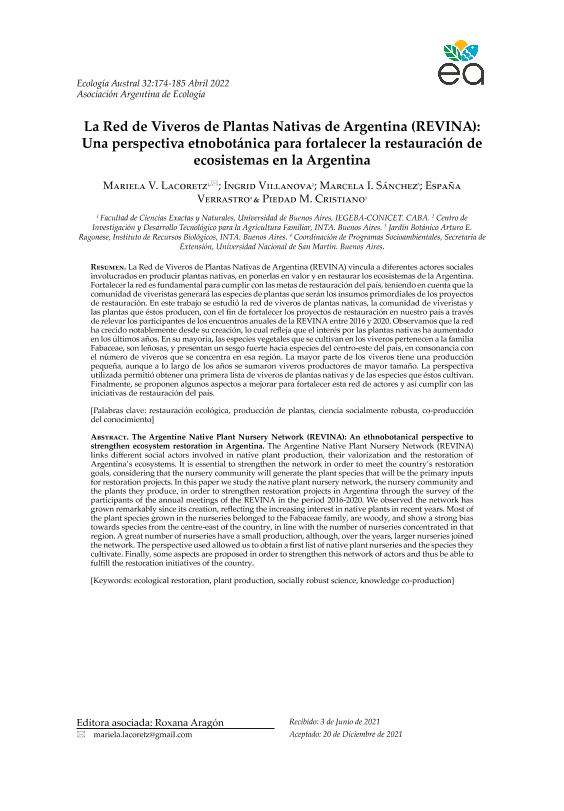Artículo
La Red de Viveros de Plantas Nativas de Argentina (REVINA) vincula a diferentes actores sociales involucrados en producir plantas nativas, en ponerlas en valor y en restaurar los ecosistemas de la Argentina. Fortalecer la red es fundamental para cumplir con las metas de restauración del país, teniendo en cuenta que la comunidad de viveristas generará las especies de plantas que serán los insumos primordiales de los proyectos de restauración. En este trabajo se estudió la red de viveros de plantas nativas, la comunidad de viveristas y las plantas que éstos producen, con el fin de fortalecer los proyectos de restauración en nuestro país a través de relevar los participantes de los encuentros anuales de la REVINA entre 2016 y 2020. Observamos que la red ha crecido notablemente desde su creación, lo cual refleja que el interés por las plantas nativas ha aumentado en los últimos años. En su mayoría, las especies vegetales que se cultivan en los viveros pertenecen a la familia Fabaceae, son leñosas, y presentan un sesgo fuerte hacia especies del centro-este del país, en consonancia con el número de viveros que se concentra en esa región. La mayor parte de los viveros tiene una producción pequeña, aunque a lo largo de los años se sumaron viveros productores de mayor tamaño. La perspectiva utilizada permitió obtener una primera lista de viveros de plantas nativas y de las especies que éstos cultivan. Finalmente, se proponen algunos aspectos a mejorar para fortalecer esta red de actores y así cumplir con las iniciativas de restauración del país. The Argentine Native Plant Nursery Network (REVINA) links different social actors involved in native plant production, their valorization and the restoration of Argentina’s ecosystems. It is essential to strengthen the network in order to meet the country’s restoration goals, considering that the nursery community will generate the plant species that will be the primary inputs for restoration projects. In this paper we study the native plant nursery network, the nursery community and the plants they produce, in order to strengthen restoration projects in Argentina through the survey of the participants of the annual meetings of the REVINA in the period 2016-2020. We observed the network has grown remarkably since its creation, reflecting the increasing interest in native plants in recent years. Most of the plant species grown in the nurseries belonged to the Fabaceae family, are woody, and show a strong bias towards species from the centre-east of the country, in line with the number of nurseries concentrated in that region. A great number of nurseries have a small production, although, over the years, larger nurseries joined the network. The perspective used allowed us to obtain a first list of native plant nurseries and the species they cultivate. Finally, some aspects are proposed in order to strengthen this network of actors and thus be able to fulfill the restoration initiatives of the country.
La Red de Viveros de Plantas Nativas de Argentina (REVINA): Una perspectiva etnobotánica para fortalecer la restauración de ecosistemas en la Argentina
Título:
The Argentine Native Plant Nursery Network (REVINA): An ethnobotanical perspective to strengthen ecosystem restoration in Argentina
Lacoretz, Mariela Verónica ; Villanova, Ingrid; Sánchez, Marcela Inés; Verrastro, Espana; Cristiano, Piedad María
; Villanova, Ingrid; Sánchez, Marcela Inés; Verrastro, Espana; Cristiano, Piedad María
 ; Villanova, Ingrid; Sánchez, Marcela Inés; Verrastro, Espana; Cristiano, Piedad María
; Villanova, Ingrid; Sánchez, Marcela Inés; Verrastro, Espana; Cristiano, Piedad María
Fecha de publicación:
01/2022
Editorial:
Asociación Argentina de Ecología
Revista:
Ecología Austral
ISSN:
0327-5477
Idioma:
Español
Tipo de recurso:
Artículo publicado
Clasificación temática:
Resumen
Archivos asociados
Licencia
Identificadores
Colecciones
Articulos(IEGEBA)
Articulos de INSTITUTO DE ECOLOGIA, GENETICA Y EVOLUCION DE BS. AS
Articulos de INSTITUTO DE ECOLOGIA, GENETICA Y EVOLUCION DE BS. AS
Citación
Lacoretz, Mariela Verónica; Villanova, Ingrid; Sánchez, Marcela Inés; Verrastro, Espana; Cristiano, Piedad María; La Red de Viveros de Plantas Nativas de Argentina (REVINA): Una perspectiva etnobotánica para fortalecer la restauración de ecosistemas en la Argentina; Asociación Argentina de Ecología; Ecología Austral; 32; 1; 1-2022; 174-185
Compartir
Altmétricas



